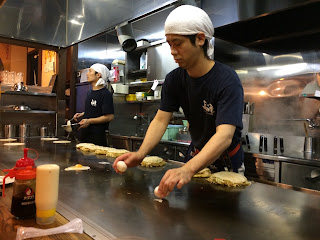

The centre of the city is bisected by a place called Peace Memorial Park, a green space dominated by over fifty statues and memorials commemorating peace, not just peace in Japan but all over the world.
Nearby, the Peace Memorial Museum is open to visitors. Wikipedia comments that: 'Be warned: a visit here, while absolutely worthwhile, will ruin your day. Allow plenty of time afterward to decompress.' This is absolutely true.

At its centre, the Atomic Bomb Dome, the epicentre where the bomb was dropped on 6 August 1945, lies as a stark reminder about the necessity of peace. Japan's post-war message is one of pacifism and that message became very clear throughout our time in the city.

The Cenotaph for the Atomic Bomb victims lies within sight of the Dome. It carries the name of every known person to die from the atomic bomb, regardless of their nationality. Over the years it has been updated to included the names of the hibakusha, Japanese individuals who were directly affected by the atomic bomb and subsequently died of radiation poisoning, cancer and other diseases thought linked to the bomb.

Paper cranes sent from children all over the world. There were cases and cases of cranes with messages attached to them:
But Hiroshima is much more than the 1945 moment in history. All across the city we were met with kind, helpful people who were busy getting on with their lives. Culinarily, we continued to eat excellent food. Okonomiyaki, the Japanese pancake we sampled in Tokyo, has two regional homes. The Osaka variation we'd already tried. But Hiroshima does it its own way and we queued outside a restaurant near the Peace Park for a local taste.

The final version was delicious but, in the end, it turns out we loved the Osaka version just a little better. Not that we told anyone.
On our final day, after a sweaty walk around Hiroshima Castle,
and in order to beat the heat, we ventured to Central Park Family Pool, a local community pool and water park. For a nominal fee, we were given a locker and proceeded to make lap after lap in the lazy river before warming ourselves on the pavement and jumping again back into the swimming pool. It wasn't fancy but it was fun.
Our final, final stop was a bar in the drinking district called Tropical Bar Revolucion. We followed the neon rooftop sign into a tiny lift and up to a bar that seated maybe ten people indoors, max. The charming bartender/proprietor informed us that it was Nobu's favourite bar and proceeded to pour us several rather strong mojitos before showing us pictures posing with famous footballers on his Okinawa holiday.
All in all we were grateful to have made our way to visit this tragic, beautiful city. Definitely important and more than meets initial expectations.







No comments:
Post a Comment